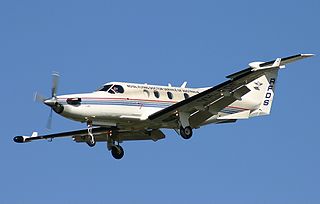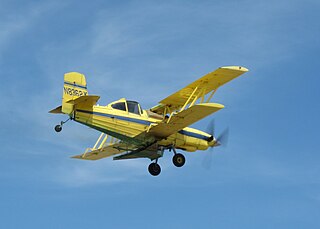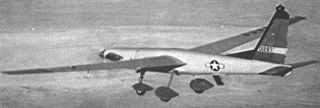AASI or Advanced Aerodynamics and Structures Inc was an aircraft maker, headquartered in Long Beach, California. The company was financed by US based Business Tycoon Late Hameed Hamza and co-owned by Darius Sharifzade and Huzefa H. to develop and manufacture a line of business aircraft of unconventional configuration, the Jetcruzer.

The Pilatus PC-12 is a pressurized, single-engined, turboprop aircraft manufactured by Pilatus Aircraft of Stans, Switzerland since 1991. It was designed as a high-performance utility aircraft that incorporates a large aft cargo door in addition to the main passenger door. Due to its efficient, high-utility design, the PC-12 is used by a large variety of operators. The main use for the aircraft is corporate transportation, but it is also used by fractional and small regional airlines, air-ambulance operators, and many government agencies, such as police departments and armed forces. The PC-12 is successful with 2,000 deliveries made as of May 2023.

The LearAvia Lear Fan 2100 was a turboprop business aircraft designed in the 1970s, with an unusual configuration. The Lear Fan never entered production.

The Grumman G-164 Ag Cat is a single-engined biplane agricultural aircraft, developed by Grumman in the 1950s.

The PZL 130 Orlik is a Polish turboprop, single engine, two seat trainer aircraft.

The Cessna Citation is a family of business jets by Cessna that started in 1972 with the entry into service of the first model. In the fifty years following the 1969 first flight, more than 7,500 Citations were delivered, forming the largest business jet fleet. Deliveries reached 8,000 by 2022, while logging over 41 million flight hours.

The Fairchild-Dornier 328JET is a commuter airliner, based upon the turboprop-powered Dornier 328, developed by the German aircraft manufacturer Dornier Luftfahrt GmbH. It would be the last Dornier-designed aircraft to reach production before the company's collapse during the early 2000s.

The Williams V-Jet II was designed and built by Burt Rutan's Scaled Composites for Williams International as a test bed and demonstrator aircraft for Williams' new FJX-1 turbofan engine.

The Cessna Citation III is an American business jet produced by Cessna and part of the Citation family. Announced at the October 1976 NBAA convention, the Model 650 made its maiden flight on May 30, 1979, received its type certification on April 30, 1982 and was delivered between 1983 and 1992. The cheaper Citation VI was produced from 1991 to 1995 and the more powerful Citation VII was offered between 1992 and 2000; 360 of all variants were delivered, while a proposed transcontinental variant, the Citation IV, was canceled before reaching the prototype stage. An all new design, the Citation III had a 312 sq ft swept wing for a 22,000 lb MTOW and a 2,350 nmi (4,350 km) range, a T-tail and two 3,650–4,080 lbf (16.2–18.1 kN) TFE731 turbofans. Its fuselage cross section and cockpit were kept in the later Citation X, Citation Excel and Citation Sovereign.

The Gulfstream G200, formerly known as the IAI Galaxy, is a twin-engine business jet. It was designed originally by Israel Aerospace Industries (IAI) and was produced by IAI for Gulfstream Aerospace from 1999 through 2011.

The Avtek 400A was an American prototype turboprop-powered business aircraft developed in the early 1980s. It was of unusual and distinctive configuration: a low-wing monoplane with two pusher engines mounted above the wings, and a large canard mounted atop the forward fuselage. The aircraft's sleek, futuristic design earned it a guest appearance on the Airwolf TV series as the X-400, the plane used by the villain Lou Stappleford in the episode Eagles.

The Gulfstream American Hustler was a 1970s American mixed-power executive/utility aircraft designed by American Jet Industries, which later changed to Gulfstream American Corporation. The aircraft had a nose-mounted turboprop and a tail-mounted turbofan.

The Cessna 500 Citation I is a small business jet produced by Cessna, the basis of the Citation family. The Fanjet 500 prototype was announced in October 1968, first flew on September 15, 1969, and was certified as the 500 Citation on September 9, 1971. It was upgraded in 1976 as the Citation I, and the 501 Citation I/SP single-pilot variant was introduced in 1977. Production ended in 1985 with 689 of all variants produced. The straight wing jet is powered by JT15D turbofans. The aircraft was developed into the Citation II.

The Cessna Citation V is a business jet built by Cessna that was in production from 1989 until 2011. During that time, 774 such craft were made. The first Model 560 prototype, a stretched version of the Citation S/II, flew in August 1987 and was certified on December 9, 1988.

The Grob Strato 2C was a German experimental high altitude research aircraft. Powered by two turbocharged piston engines and featuring an extremely long span wing of composite construction, one aircraft was built in the 1990s, but was abandoned despite setting a world altitude record for piston-engined aircraft on its last flight.

The Ling-Temco-Vought XQM-93 was a remotely piloted aircraft developed in the United States in the late 1960s and early 1970s for use as a communications relay in the Vietnam War. A prototype flew in 1970, but the program was abandoned without producing a service-ready aircraft.
The Atlas ACE is a South African turboprop trainer, that was designed by the Atlas Aircraft Corporation as a contender to replace the North American Harvard in service with the South African Air Force. The aircraft was not selected and only two examples were completed.

The Epic LT is an American kit-built single-engined turboprop aircraft intended for use by private pilots. The Epic Dynasty was the proposed certified version of the LT that was intended be sold as a completed aircraft, prior to Epic Aircraft's bankruptcy in August 2009 and later acquisition by new owners in April 2010. Under ownership of the reorganized company, the certificated version is to be called the E1000, with first deliveries initially scheduled for 2015, but delayed until 2019.

The Cessna Citation Latitude is a business jet built by Cessna. The Model 680A was announced at the 2011 NBAA convention, the prototype first flew on 18 February 2014, it achieved FAA certification on June 5, 2015, and first deliveries began on August 27. It retains the Model 680 Sovereign wing, twin P&WC PW306D turbofans and cruciform tail and adds a new stand-up circular fuselage with a flat floor, which was kept in the stretched, re-winged, and re-engined Cessna Citation Longitude.
The Stratos 714 is an American very light jet aircraft under development by Stratos Aircraft of Redmond, Oregon. The project was announced in July 2008, a prototype first flew on 21 November 2016, although Stratos currently lacks the funding to complete type certification. Predominantly made of carbon composite, the single turbofan aircraft would seat four to six at 400 kn (740 km/h) over up to 1,500 nmi (2,800 km).


















